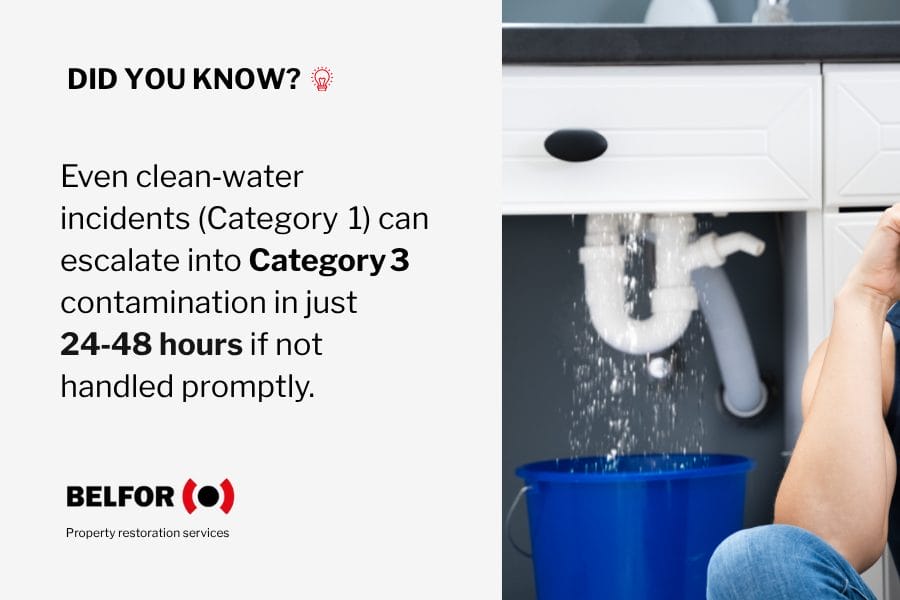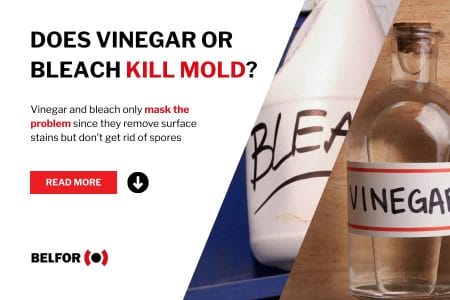Category 3 Water Damage: 2026 Guide on How To Handle It

Category 3 Water Damage: Key Takeaways
- When water damage is considered Category 3 (often called ‘black water’), you’re dealing with the most serious contamination level, think raw sewage, storm‑run‑off, toilet waste, and other hazardous fluids
- Mold and other microbial growth can get going in just 24 to 48 hours, so what seems like a ‘wait until tomorrow’ situation could already be costing you thousands in extra damage
- Because of the serious biohazard risks and regulatory requirements, cleanup of a Category 3 loss should always be handled by technicians certified by the Institute of Inspection Cleaning and Restoration Certification (IICRC)
- Think your home insurance has you covered? Not always. Without flood or sewer-backup protection, many people find out the hard way, after the damage is done
- From emergency intervention and water damage cleanup through full‑scale reconstruction and claims support, our team at BELFOR Property Restoration is here to stand by you every step of the way
Did you know that water damage is the second most common insurance claim in the U.S., costing homeowners over $20 billion a year?
While some leaks can be cleaned with a towel, Category 3 water damage, also known as black water, is in a league of its own.
This isn’t just dirty water. It’s contaminated with raw sewage, bacteria, and potentially life-threatening pathogens.
In this guide, we will cover:
- What Category 3 water damage is and what makes it so dangerous
- The most common causes and how to spot them early
- Real-world examples of black water disasters (and how to respond)
- The full professional cleanup process, step-by-step
- What insurance may or may not cover, and how to protect yourself
Common Causes of Category 3 Water Damage
Category 3 water, or black water, is dangerously contaminated and poses serious health and safety risks.
Here are the most common causes explained:
- Sewage backups: Caused by clogged drains, collapsed sewer lines, or overloaded municipal systems. They’re highly toxic and contain harmful bacteria, such as E. coli, and viruses including Hepatitis A, Norovirus, and Rotavirus. Exposure can lead to severe gastrointestinal and respiratory infections.
- Natural flooding (rivers, flash floods, storm surge): Even clean-looking floodwater is considered Category 3 if it has touched soil, roads, or sewage systems. It often carries pesticides, fuel residue, animal waste, and industrial runoff. Only one inch of floodwater can cause over $25,000 in property damage.
- Toilet overflows with solid waste: When toilets overflow with feces or urine, the water is instantly classified as Category 3. It’s hazardous due to direct exposure to raw human waste, which can spread pathogens rapidly through flooring and walls if not addressed immediately.

How To Respond to Category 3 Water Damage
When you’re faced with Category 3 water damage, every minute counts.
This isn’t just a mess; it’s a serious health hazard.
Follow these steps to respond quickly and effectively.
1. Prioritize Safety and Evacuate the Area
Category 3 water is loaded with dangerous pathogens and toxins.
Direct contact or prolonged exposure can lead to serious illness, especially for children, seniors, and those with weakened immune systems.
What to do immediately:
- Evacuate anyone in contact with the contaminated area
- Avoid touching or attempting to clean the water yourself
- If the water is near outlets or electrical panels, shut off power from a safe location
2. Prevent the Spread of Contamination
The faster you act to isolate the damage, the less it can spread through your home or business.
Use physical barriers and minimize foot traffic.
How to reduce damage and exposure:
- Close doors to affected areas and avoid walking through the water
- Block off vents or air returns nearby to prevent airborne spread
- Remove pets from the area immediately
3. Document the Category 3 Water Damage for Insurance
Your insurance provider will need clear documentation to process your claim accurately.
Safely gather evidence as long as you’re not risking exposure.
Smart documentation steps:
- Take wide shots of the room and close-ups of anything soaked. It might not seem urgent now, but your insurer will thank you later
- Make note of when the damage occurred and what you observed
- Save receipts for any emergency purchases or temporary housing
4. Call a Certified Water Damage Restoration Company
Category 3 water requires a professional response.
Don’t wait, call BELFOR or another certified provider as soon as you’re safe.
Why certified help matters:
- IICRC-certified teams follow strict safety and decontamination protocols
- Emergency response vehicles can arrive within hours to stabilize the site
- Professionals handle everything from hazardous waste removal to full structural restoration

How To Prevent Cat 3 Water Damage
Preventing black water emergencies starts with simple maintenance and smart upgrades.
Use this checklist to stay ahead of potential Category 3 water disasters:
- Install backwater valves, as they stop sewage from backing into your home
- Inspect plumbing annually so you can catch leaks or pipe failures
- Maintain your sump pump, test it regularly and install a battery backup for power outages
- Clean gutters and downspouts to ensure water flows away from your foundation, not into it.
- Seal basement and entry points, use caulk and barriers to keep floodwater out
- Use smart leak detectors and get instant alerts when appliances or pipes start leaking
Check Your Insurance Before It’s Too Late
Many Category 3 claims are denied if proper coverage isn’t in place.
Ask your agent:
- Do I have flood or sewer backup coverage?
- Will restoration services be reimbursed immediately?
- Can preventive upgrades lower my premium?
Pro tip: Add coverage now, not after the damage is done.
Professional Cleanup Process for Cat 3 Water Damage
Category 3 water damage isn’t just a dirty job; it’s a hazardous emergency that demands certified expertise, strict safety protocols, and industrial-grade tools.
Here’s how trained professionals handle water damage and repair jobs.
Step 1: Assess and Contain the Contaminated Area
Before touching a mop or turning on a fan, the process is started by assessing how far the damage extends and how to prevent it from spreading.
Key containment actions include:
- Hazard evaluation and moisture mapping: Identifying water migration paths using thermal imaging and moisture meters
- Establishing negative air pressure zones: HEPA-filtered machines prevent airborne pathogens from spreading
- Use of PPE and barriers: Full-body suits, gloves, respirators, and plastic sheeting help ensure safety and regulatory compliance
Step 2: Extract, Remove, and Decontaminate
Once the site is secure, technicians begin removing water and contaminated materials while neutralizing pathogens.
This stage is critical to stop the spread of bacteria and mold.
Critical steps during extraction and cleaning:
- Industrial water extraction and removal: High-powered vacuums and pumps quickly eliminate standing water and sewage
- Disposal of unsalvageable materials: Drywall, flooring, insulation, and porous items are safely discarded per EPA and OSHA guidelines
- Application of EPA-registered disinfectants: Professionals use hospital-grade disinfectants, not stuff you find at the store, to wipe out bacteria, viruses, and lingering spores
Step 3: Dry, Restore, and Prevent Future Contamination
Once surfaces are cleaned, the structure must be dried and restored to a safe, livable condition.
Final inspections and prevention measures help ensure the damage doesn’t return.
Final remediation steps include:
- HEPA drying and air scrubbing: Industrial fans and air scrubbers eliminate moisture and improve air quality
- Structural repairs and reconstruction: BELFOR restores drywall, flooring, and finishes, returning your space to pre-loss condition
- Preventive recommendations: Technicians may install moisture sensors or suggest backflow valves to prevent future Cat 3 incidents
Trust BELFOR for Fast, Safe, and Total Category 3 Water Damage Restoration
When you’re dealing with Category 3 water damage, you need more than a mop, you need a trusted partner who can act fast, restore fully, and protect what matters most.
At BELFOR, we’ve helped thousands of property owners recover from the worst-case scenarios, including sewage backups, storm floods, and major black water losses.
Whether it’s your home or business, we’re here to handle everything so you don’t have to.
Why choose BELFOR?
- 24/7 emergency response, nationwide
- Certified cleanup experts for biohazard and water loss
- Complete restoration, not just cleanup
- Support with documentation and insurance claims
- Over 70 years of experience, global resources, local care
Category 3 Water Damage: FAQs
If we haven’t answered all of your questions above, here are some questions you still might be asking yourself.
What is Category 3 water damage?
Category 3 water damage, also known as black water, involves highly contaminated water that can contain sewage, chemicals, bacteria, and pathogens. It poses serious health risks and requires professional cleanup.
How can I tell if water damage is Category 3?
If the water came from a sewer backup, toilet overflow with feces, natural flooding, or has sat for more than 48 hours, it’s likely Category 3. Look for strong odors, discoloration, and signs of biological waste.
Is Cat 3 water damage dangerous?
Yes. Category 3 water can spread bacteria like E. coli and viruses such as Hepatitis A and Norovirus, putting your health at serious risk. Do not touch or attempt to clean it without professional help.
Does homeowners’ insurance cover this water damage?
It depends. You’d think your insurance has your back, but unless you’ve specifically added sewer or flood protection, you could be stuck paying out-of-pocket.
Can I clean up the water damage myself?
No, it’s not safe. Due to the biohazards involved, only IICRC-certified professionals should handle Category 3 cleanup using proper protective equipment, industrial disinfectants, and containment protocols.
How long does it take to clean up Category 3 water damage?
Most cleanups take 3–7 days, depending on the severity and size of the area. This includes water extraction, decontamination, structural drying, and repairs.
What should I do first if I have this type of water damage?
Evacuate the area immediately, avoid contact with the water, and call a certified water damage restoration provider like BELFOR.
.jpg)
![Mold In Air Vents & Ducts [Causes & 2026 Cleaning Guide]](https://www.belfor.com/us/wp-content/uploads/sites/2/2025/10/mold_in_air_vents_and_ducts_hero_image-450x300.jpg)

![Hoarding Cleaning Services Guide [Costs, Pro Tips & More]](https://www.belfor.com/us/wp-content/uploads/sites/2/2025/10/hoarding_cleaning_services_hero_image-450x300.jpg)